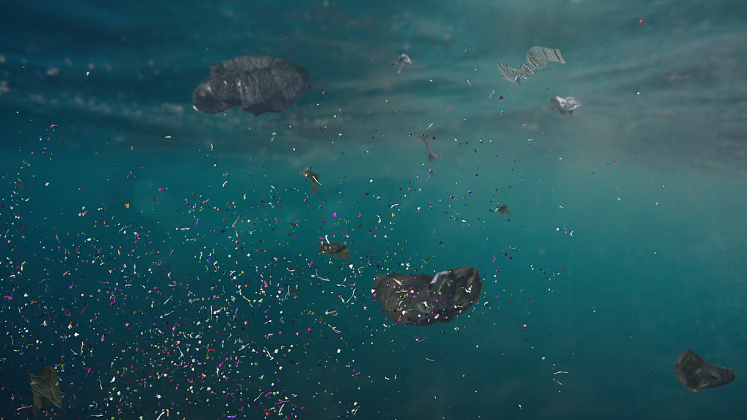New paper finds microplastics at 100 metre depth in oceans, disrupting its carbon cycle; researchers warns of rising pollution levels

Plastic pollution in the ocean has extended far beyond floating surface debris — microplastics have become so deeply embedded in the ocean’s structure that they are now altering the planet’s biogeochemical cycles, scientists have warned in a new study.
A study published in the journal Nature highlighted that microplastics — particles between 1 and 100 micrometres in size — dominate the marine environment. While larger plastic fragments (100 to 5,000 micrometres) were typically concentrated near the ocean surface, smaller particles were discovered embedded as deep as 100 metres within ocean gyres.
Gyres are circular water currents in ocean basin and act like huge, slow-moving whirlpools that arrest and concentrate floating debris, mainly plastic.
Although the presence of microplastics throughout the ocean water column has been known, this study marked the first time researchers analysed their vertical distribution across depths in such detail.
The researchers synthesised data from 1,885 ocean stations gathered between 2014 and 2024 to understand how microplastics travel through the water column. They focused on the subsurface layer, defined as approximately 50 centimetres below the surface.
They detected more than 56 polymer types in the dataset, with buoyant polymers — representing nearly half of global plastic production — dominating subsurface microplastic presence.
The water column, which comprises the majority of Earth’s habitable environment, plays a crucial role in biogeochemical cycling. Researchers warned that it is increasingly impacted by microplastics, which in turn may be affecting the ocean’s carbon cycle.
The study noted that subsurface microplastics sampling is concentrated in the Atlantic and Atlantic-Arctic oceans.
“High abundances have been consistently observed in deep waters, including over 1,100 particles per m³ at 100–270 m in a North–South Atlantic transect, 600 particles per m³ at 2,000 m in the North Pacific Subtropical Gyre, 200 particles per m³ at 2,500 m in the Arctic and 13,500 particles per m³ at 6,800 m in the Mariana Trench,” the study observed.
Along South Korea’s coast alone, an estimated 3.13 trillion microplastic particles (ranging from 0.33 to 4.75 millimetres in size) were present in the water column. While this accounted for only a fraction of the estimated 171 trillion floating plastic particles globally, it nonetheless highlighted the scale of the problem, the paper said.
In the Atlantic Ocean, microplastics sized between 32 and 651 micrometres were detected in the top 200 metres at an average concentration of 2,200 particles per cubic metre. The estimated total mass was between 11.6 and 21.1 million metric tonnes.
This mass was comparable to the total input of plastics larger than 300 micrometres into the Atlantic Ocean and its sediments between 1950 and 2015, which was estimated at 17-47 million metric tonnes.
The study, however, cautioned that the estimates came with a high degree of uncertainty due to inconsistent sampling methods, limited data resolution and simplified assumptions about ocean dynamics.
They observed that microplastic concentrations generally declined with depth, especially in nearshore waters, where levels dropped up to 1,000-fold compared to offshore areas.
The study also found that dense microplastics were unevenly distributed in smaller size fractions, particularly in the North Pacific Subtropical Gyre. These dense plastics — such as PET, often used in beverage bottles — likely underwent extensive weathering and degradation before reaching open ocean gyres, having taken years to travel from land-based sources.
A separate study in the same gyre revealed that nearly half the sampled plastics with identifiable production dates originated from the 20th century, underscoring the longevity of plastic pollution and its capacity for microplastic generation over time. Fishing gear, including nets made from nylon and polyester, was identified as a major source of dense microplastic pollution.
The new study also pointed to atmospheric sources of pollution. “The atmosphere-ocean influx of microplastics, estimated to range from 0.013 million tonnes to 25 million tonnes annually, may also contribute, with polyester comprising a significant fraction of airborne microplastics,” the research said.
Crucially, the researchers stated that plastic debris now represented a measurable component of the ocean’s carbon cycle. The study found that plastic pollution adds external carbon (called allochthonous carbon) to marine ecosystems. This is measured by looking at the mass of plastic particles and the amount of carbon in the chemical makeup of common plastics.
The analysis showed that the ratio of microplastic carbon to total particulate organic carbon (POC) increased with ocean depth in subtropical gyres. Microplastic carbon made up just 0.1 per cent of total POC at 30 metres, but this rose to 5 per cent at depths of 2,000 metres.
This proportion is expected to increase over time and the microplastics used by organisms like microbes — along with the substances they release during digestion like metabolites and organic debris — can affect natural processes like nitrification and denitrification in the environment.
This has major implications for marine carbon dating. “A 5 per cent contribution of plastic-C could make marine POC samples appear approximately 420 years older than their true apparent age,” the paper said.
The researchers called for long-term studies to better understand the impact of plastics in their biological cycles.
Article Credit: downtoearth